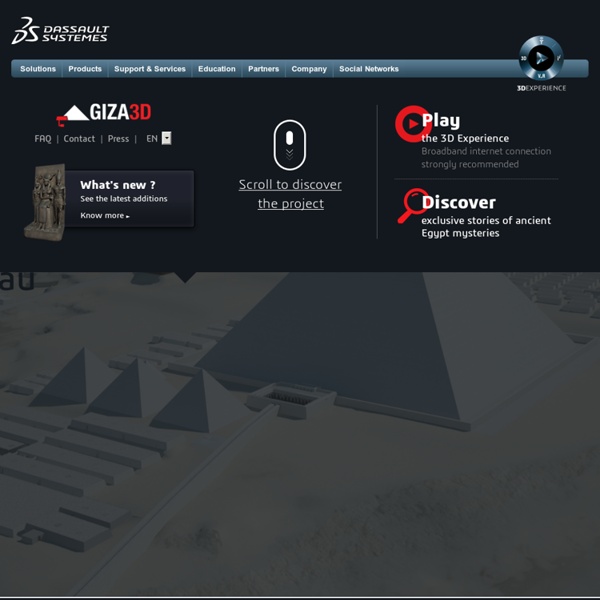



https://org-www.3ds.com/giza3dorg/#discover
Related: VISITES VIRTUELLES • ARTSAcropole d'Athènes The Propylaia, famous already in antiquity for its brilliant coffered ceilings and the unique design of the monumental entrance to the sanctuary of Athena, was a work of the architect Mnesikles (437-432 B.C.). It consists of a central building with two six-columned Doric porticoes east and west and two Ionic colonnades in the interior, framed at the north and south by two wings with porches in the Doric order. The outbreak of the Peloponnesian War meant that the final work on the surfaces of the monument was never completed. The destruction of most of the superstructure of the central building during the years 1640-1830 , after the explosion of gunpowder that was stored in the monument by the Turks, has led to a gradual loss of authentic building material, so that until now no more than one fifth of it had been recognised.
TZM Response To ‘Kony 2012′ Campaign Recently, a viral phenomenon flared up as a result of a video campaign entitled ‘Kony 2012′, which encourages the viewer to become passionate about chasing down a man named Joseph Kony, who is apparently involved in gang warfare, rape, severe child abuse, slavery, murder and the like in Uganda and it’s neighbouring countries. This is obviously extremely inhumane and abhorrent behaviour to say the least. The methods in which the film presents the problem are very emotive, and judging by the public response, appears very effective on pulling on the viewer’s heartstrings.
Excavation Report: Architectural Remains at Abusir-south Click here for Japanese version The Research at Abusir At the site of Abusir, about 10 km south of the Giza plateau, there is another large royal cemetery of the Old Kingdom. The cemetery is composed of four kings' pyramids belonging to the 5th Dynasty and surrounding tombs built by royal family and officials, which is a typical layout of royal cemeteries in the Old Kingdom. Titans of Space - Unimersiv A short guided tour of a the planets of our solar system through virtual reality It’s not meant to be realistic, but more on the surreal holographic side. Everything you see is initially shrunk down to 1 millionth of their actual size, which means you will see Earth as a 12.7-meter-wide holographic ball, rather than the giant 12756km-wide ball of rock that it is. Although the tour is on rails, you can proceed through it at your own pace.
The Pyramids The Pyramids - 3D Virtual Tour The Pyramids virtual tours can be started by clicking the preview window or by downloading the stand-alone versions. Just drag the mouse to the direction you want to look. Use the scroll wheel to zoom at the details. Press F9 to get a list of the 3D sites you downloaded (residing in the same directory).
SushiBot Serves Up An Order Of 3,600 Per Hour The SushiBot moulds rice mounds by the thousands so sushi chefs don't have to. Talk about “fast food,” a Japanese company just unveiled its SushiBot at the World Food and Beverage Expo in Tokyo. The countertop-sized robot makes the chef’s job easier by balling rice up into the small elongated mounds upon which fish and other ingredients are placed. Excavations in Saqqara (Egypt) Excavation Saqqara: supervisor Maarten Raven (Rijksmuseum van Oudheden) Excavation Saqqara: supervisor Harold Hays (Leiden University) Egyptian working men are moving an object The project Dinosaurs - Unimersiv Walk in a valley to meet 16 species of dinosaurs Dinosaurs first appeared during the Triassic period, 231.4 million years ago, and were the dominant terrestrial vertebrates for 135 million years, from the beginning of the Jurassic (about 201 million years ago) until the end of the Cretaceous (66 million years ago). How to use Press SPACE bar for the menu, move up and down with arrow keys to select a dinosaur, then press ENTER to be teleported. This application works nice for individual experience, but the original purpose is to help teachers using VR in the classroom to contextualize their lessons about dinosaurs.
Mount Everest-Monte Everest -360 panorama view from summit - Climbing Mt Everest - Nepal Trekking-panoramic photo from top of Mont Everest It is from a book titled Everest: Reflections From the Top by Christine Gee & Garry Weare which just been published. New Energy Movement - technology assessment New Energy Movement has established itself primarily as an educational resource and advisory body seeking to inspire an energy revolution. Amongst our Board members and associates are individuals who have distinguished themselves as teachers, innovators, authors and world renown speakers. Familiar with the vast array of New Energy principles and technologies, we are continuously engaged in the study of these emerging developments. It is the immediate-term goal of New Energy Movement to identify and publicly disseminate the technologies that have proven to be truly unconventional advances in the science of energy generation. We heartily endorse the work of Sterling Allan, founder of Pure Energy Systems, in his efforts to establish the New Energy Congress.We encourage all who support this movement to join the New Energy Congress as it works toward a robust 'open source' network assessing the promise of candidate technologies.
Giza Plateau Mapping Project Print this Page Home > Research > Projects > The Giza Plateau Mapping Project The Giza Plateau Mapping Project, under the direction of Mark Lehner, Visiting Assistant Professor of Egyptian archaeology at the Oriental Institute, is dedicated to research on the geology and topography of the Giza plateau, the construction and function of the Sphinx, the Great Pyrimids, the associated tombs and temples, and the Old Kingdom town in the vicinity.